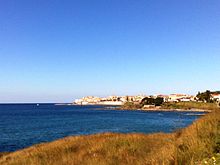Diamante (Calabria)
| Diamante | ||
|---|---|---|

|
|
|
| Country | Italy | |
| region | Calabria | |
| province | Cosenza (CS) | |
| Coordinates | 39 ° 41 ′ N , 15 ° 49 ′ E | |
| surface | 11 km² | |
| Residents | 5,238 (Dec. 31, 2019) | |
| Population density | 476 inhabitants / km² | |
| Post Code | 87023 | |
| prefix | 0985 | |
| ISTAT number | 078048 | |
| Popular name | Diamantesi or Adamantini | |
| Patron saint | Immacolata Concezione | |
| Website | www.comune-diamante.it | |
Diamante is a coastal village in the province of Cosenza in the region of Calabria in Italy with 5238 inhabitants (December 31, 2019).
Location and dates
Diamante is 78 km north of Cosenza on the western coast of Calabria. The tourism is the main source of income of the population, other sources of income are fishing and the production of lemon peel .
The neighboring communities are Belvedere Marittimo , Buonvicino , Grisolia and Maierà .
history
In the 15th century, Diamante belonged to the Neapolitan princely family Carafa .
Attractions
One of the oldest structures is a tower that was built around 1500 near the mouth of the Corvino . The Chiesa dell'Immacolata Concezione from the 17th century houses a figure of the Madonna that is very revered by believers. The place is particularly known for its wall paintings, the murales , which were created in 1981 by around 80 artists. In 1986 they were supplemented with texts by writers and poets.
particularities
Citron Lemon
After the town of Diamante there is a special variety of citron , the Diamante lemon ( Citrus medica var. Vulgaris or Citrus medica cv. Diamante ; Italian cedro di diamante , Hebrew אתרוג קלבריה or גינובה) named. The only region of the world in which this variety is grown extends over an almost 40 kilometer long coastal strip from the Calabrian neighboring town of Tortora to Belvedere Marittimo . Lemon lemons, such as the Diamante lemons, are primarily processed into lemon peel , but lemon lemons also play a ritual role in Judaism as so-called etrogs at the Feast of Tabernacles . The etrog belongs to the festive bouquet prescribed in Leviticus 23:40, which is formed from a palm branch ( lulav ), myrtle branch (Hadassim), brook willow (Arawot) and apple of paradise (etrog).
The different groups within Judaism use different varieties of the citron as an etrog, the garden historian Attlee speaks of at least 12 clearly distinguishable varieties. The determination is made by the respective Posek . The Lubavitch Jews , a Hasidic group within Orthodox Judaism , use only the Diamante lemon as an etrog on the instructions of their Rebbe Menachem Mendel Schneerson and are therefore dependent on the lemon that grows in the region between Tortora and Belvedere Marittimo. The trees are harvested twice a year. The harvest time, which takes place around August, is used almost exclusively for the festival of tabernacles. During this time there are numerous representatives of this faith in northern Calabria who monitor that the fruits come from plantations that meet the requirements and buy suitable fruits for the Lubowitscher communities that are today all over the world. Only a very small part of the harvest meets the high demands on Etrog . The fruits used for the Feast of Tabernacles must not show any traces of insect damage and must be uniform in color. Perfect fruits that meet the requirements are traded for prices between € 25 and € 250.
The use of this variety is conclusive: the Jewish migrants who settled in Italy, Sicily, Greece and Spain after the conquest of Jerusalem in AD 70, introduced the lemon that they had previously grown in the Holy Land . The citron is generally the first citrus plant to be grown on the European continent.
Festival del peperoncino
Every year in the first days of September the “Festival del peperoncino” ('Chili Festival') takes place. It is a cultural and gastronomic festival that has been held since 1992. The journalist Enzo Monaco conceived it to mark the five hundredth anniversary of the discovery of America, an event to commemorate the introduction of peppers and chilli in Europe and in Calabrian cuisine.
literature
- Helena Attlee: The Land Where Lemons Grow: The Story of Italy and its Citrus Fruit. Penguin Books, London 2015, ISBN 978-0-14-196786-8 .
- Gabriella Vitiello, Frank Helbert: Calabria. DuMont-Reise-Verlag, Cologne 2004, ISBN 3-7701-6439-3 .
- Ilona Witten: Calabria. 2nd, updated edition. DuMont-Reiseverlag, Ostfildern 2006, ISBN 3-7701-5989-6 .
Web links
- Photo gallery of the murals on the municipality's website; Retrieved April 12, 2016
Individual evidence
- ↑ Statistiche demografiche ISTAT. Monthly population statistics of the Istituto Nazionale di Statistica , as of December 31 of 2019.
- ↑ a b c d Helena Attlee: The Land Where Lemons Grow . P. 177.
- ↑ Helena Attlee: The Land Where Lemons Grow . P. 197.




